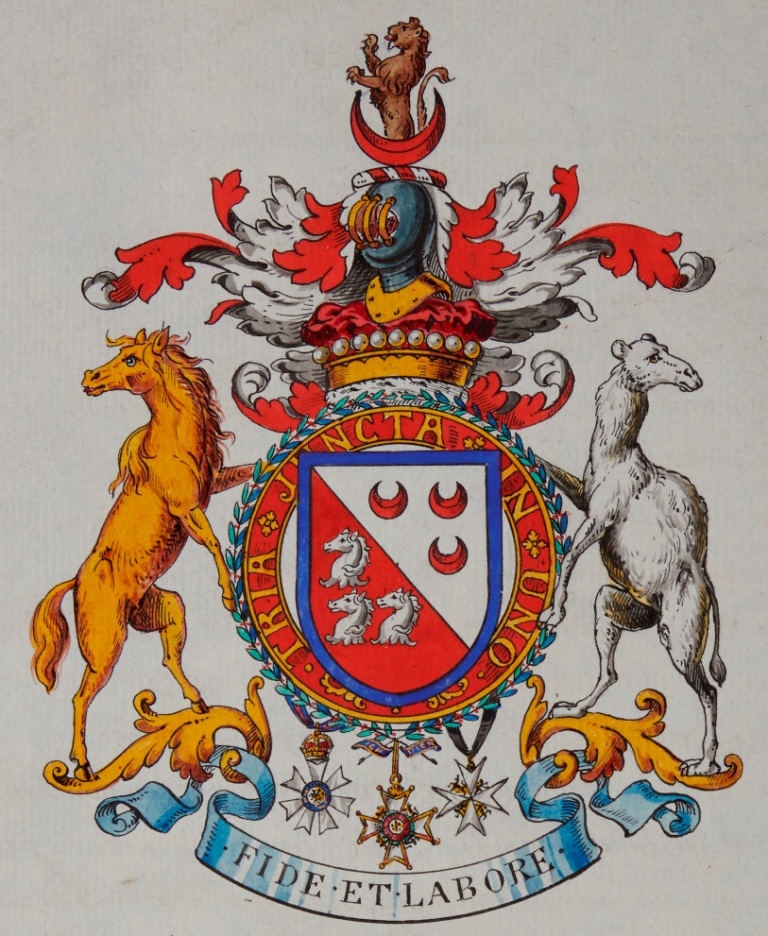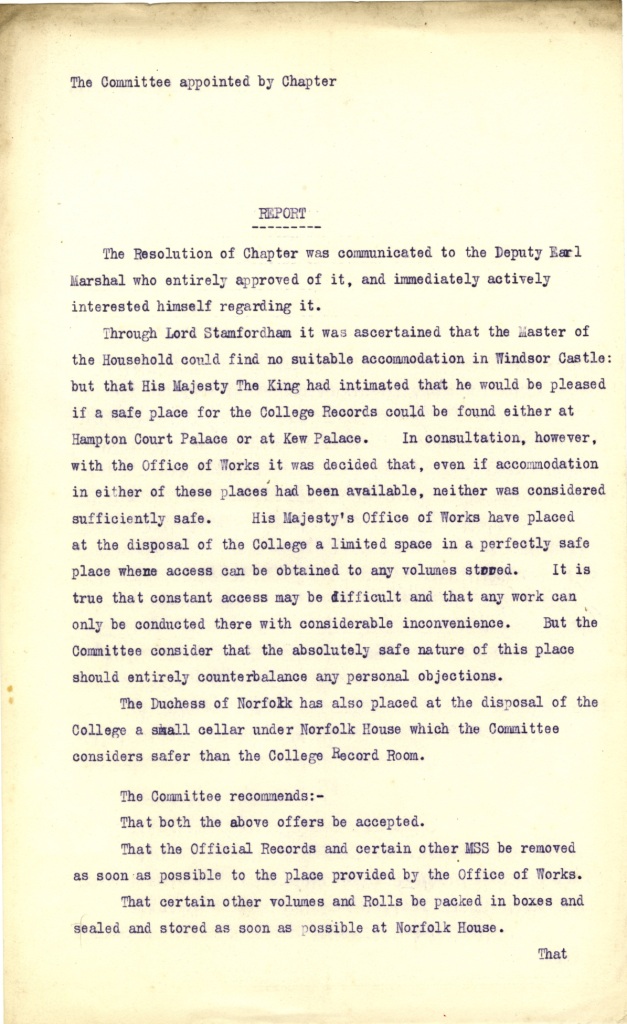To mark the Armistice and the conclusion of the First World War, we present a brief online exhibition of images relating to the conflict and the heralds' reactions to it.
 In the first meeting of the Chapter of College held after War was declared, Officers discussed the threat of zeppelin raids. It was agreed to appoint a night watchman and to insure the building against enemy aircraft damage should the worst occur. This page from the Treasurer’s Accounts of 1918 shows the ongoing payments.
In the first meeting of the Chapter of College held after War was declared, Officers discussed the threat of zeppelin raids. It was agreed to appoint a night watchman and to insure the building against enemy aircraft damage should the worst occur. This page from the Treasurer’s Accounts of 1918 shows the ongoing payments.
College of Arms reference: Treasurer’s Accounts p. 107
 On 3 September 1914, at the first meeting of the Chapter of College after War was declared, it is minuted that Algar Howard, Rouge Dragon Pursuivant of Arms and a yeomanry officer, had been mobilized and was already at the Front. In this minute of the July 1919 meeting of Chapter, he is welcomed back after five years' service and the award of the Military Cross.
On 3 September 1914, at the first meeting of the Chapter of College after War was declared, it is minuted that Algar Howard, Rouge Dragon Pursuivant of Arms and a yeomanry officer, had been mobilized and was already at the Front. In this minute of the July 1919 meeting of Chapter, he is welcomed back after five years' service and the award of the Military Cross.
College of Arms reference: Chapter Book 18 p. 161
 The standard granted to Algar Howard, Rouge Dragon Pursuivant of Arms, in 1913. Made Windsor Herald in 1919, then Norroy King of Arms in 1931, in 1943 Howard became the first Norroy and Ulster King of Arms when the two offices were merged. During the Second World War many College records were sent for safekeeping to his home, Thornbury Castle in Gloucestershire.
The standard granted to Algar Howard, Rouge Dragon Pursuivant of Arms, in 1913. Made Windsor Herald in 1919, then Norroy King of Arms in 1931, in 1943 Howard became the first Norroy and Ulster King of Arms when the two offices were merged. During the Second World War many College records were sent for safekeeping to his home, Thornbury Castle in Gloucestershire.
College of Arms reference: Standards 1, p. 106
 Arms granted to Field Marshal Edmund Allenby, 1st Viscount Allenby, GCB, GCMG, GCVO (1861 – 1936). The supporters, a horse and a camel, symbolise aspects of his military career: he commanded the cavalry division of the British Expeditionary Force on the Western Front, then from 1917 was Commander-in-Chief of the Egyptian Expeditionary Force in Palestine. The shield is enclosed in the circlet of the Order of the Bath, of which he was appointed Knight Grand Cross in 1918.
Arms granted to Field Marshal Edmund Allenby, 1st Viscount Allenby, GCB, GCMG, GCVO (1861 – 1936). The supporters, a horse and a camel, symbolise aspects of his military career: he commanded the cavalry division of the British Expeditionary Force on the Western Front, then from 1917 was Commander-in-Chief of the Egyptian Expeditionary Force in Palestine. The shield is enclosed in the circlet of the Order of the Bath, of which he was appointed Knight Grand Cross in 1918.
College of Arms reference: Grants 87 p. 22
 In the summer of 1917, concern about the possibility of air raids led to the decision that “the ancient Rolls of Arms, and the most interesting of the ancient records of the College” be moved from their usual place of storage to a strongroom within the building. A report was commissioned on the possibility of extra protection for the Record Room against aircraft damage, but it was decided not to proceed in the matter.
In the summer of 1917, concern about the possibility of air raids led to the decision that “the ancient Rolls of Arms, and the most interesting of the ancient records of the College” be moved from their usual place of storage to a strongroom within the building. A report was commissioned on the possibility of extra protection for the Record Room against aircraft damage, but it was decided not to proceed in the matter.
College of Arms reference: Chapter Book 18 pp 120-121
 In May 1918 certain series of records were removed to a place of safety. This minute records discussions preceding the move, although later it was decided not to use the cellar under Norfolk House. So carefully was secrecy about the location maintained that it remains unknown to this day.
In May 1918 certain series of records were removed to a place of safety. This minute records discussions preceding the move, although later it was decided not to use the cellar under Norfolk House. So carefully was secrecy about the location maintained that it remains unknown to this day.
College of Arms reference: Chapter Papers 18
 Arms of General Henry Seymour Rawlinson, 1st Baron Rawlinson, GCB, GCSI, GCVO, KCMG (1864 – 1925). Rawlinson held various senior commands on the Western Front, including that of the 4th Army at the Somme. After the War, he was appointed Commander-in-Chief in India. The Supporters, granted in 1919, are blazoned as: To the dexter an Infantryman of the British Expeditionary Force and to the sinister an Infantryman of the Australian Imperial Force each supporting with the exterior hand a Rifle with fixed Bayonet all proper.
Arms of General Henry Seymour Rawlinson, 1st Baron Rawlinson, GCB, GCSI, GCVO, KCMG (1864 – 1925). Rawlinson held various senior commands on the Western Front, including that of the 4th Army at the Somme. After the War, he was appointed Commander-in-Chief in India. The Supporters, granted in 1919, are blazoned as: To the dexter an Infantryman of the British Expeditionary Force and to the sinister an Infantryman of the Australian Imperial Force each supporting with the exterior hand a Rifle with fixed Bayonet all proper.
College of Arms reference: Grants 87 p. 66
 Changes of name and Arms by Royal Licence are arranged by the Officers of the College of Arms and placed on official record in the College. During the First World War, members of the Royal family relinquished their German surnames, styles and titles. This page records the Royal Licence granted by George V, by which Prince Louis of Battenberg relinquished the titles ‘Serene Highness’ and ‘Prince’ and changed the designation ‘of Battenberg’ to the English surname ‘Mountbatten’.
Changes of name and Arms by Royal Licence are arranged by the Officers of the College of Arms and placed on official record in the College. During the First World War, members of the Royal family relinquished their German surnames, styles and titles. This page records the Royal Licence granted by George V, by which Prince Louis of Battenberg relinquished the titles ‘Serene Highness’ and ‘Prince’ and changed the designation ‘of Battenberg’ to the English surname ‘Mountbatten’.
College of Arms reference: I. 78, p. 9
 Arms of Admiral of the Fleet David Richard Beatty, 1st Earl Beatty GCB, OM, GCVO, DSO, PC (1871 – 1936). Beatty led the 1st Battlecruiser Squadron at battles including Heligoland Bight and Jutland. He was subsequenrly Commander in Chief of the Grand Fleet. In 1919 he was promoted to Admiral of the Fleet and created an Earl; he then served as First Sea Lord, professional head of the Royal Navy. He was granted Arms, Crest and Supporters by Letters Patent of the Kings of Arms dated 29 December 1919. The devices on his shield are a pun on his name; while the Supporters signify his career and are blazoned as: to the dexter a Sailor of the Royal Navy and to the sinister a Soldier of the Royal Marines both proper.
Arms of Admiral of the Fleet David Richard Beatty, 1st Earl Beatty GCB, OM, GCVO, DSO, PC (1871 – 1936). Beatty led the 1st Battlecruiser Squadron at battles including Heligoland Bight and Jutland. He was subsequenrly Commander in Chief of the Grand Fleet. In 1919 he was promoted to Admiral of the Fleet and created an Earl; he then served as First Sea Lord, professional head of the Royal Navy. He was granted Arms, Crest and Supporters by Letters Patent of the Kings of Arms dated 29 December 1919. The devices on his shield are a pun on his name; while the Supporters signify his career and are blazoned as: to the dexter a Sailor of the Royal Navy and to the sinister a Soldier of the Royal Marines both proper.
College of Arms reference: Grants 87 p. 76
 By ancient tradition, heralds are proclaimers of peace. This article from Country Life magazine of July 1919 describes Officers of Arms reading the proclamation of peace at various locations across London.
By ancient tradition, heralds are proclaimers of peace. This article from Country Life magazine of July 1919 describes Officers of Arms reading the proclamation of peace at various locations across London.
College of Arms reference: Acc 2010/2

